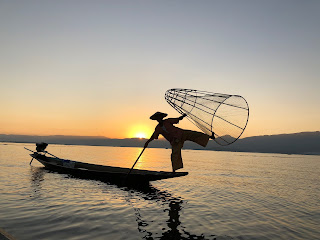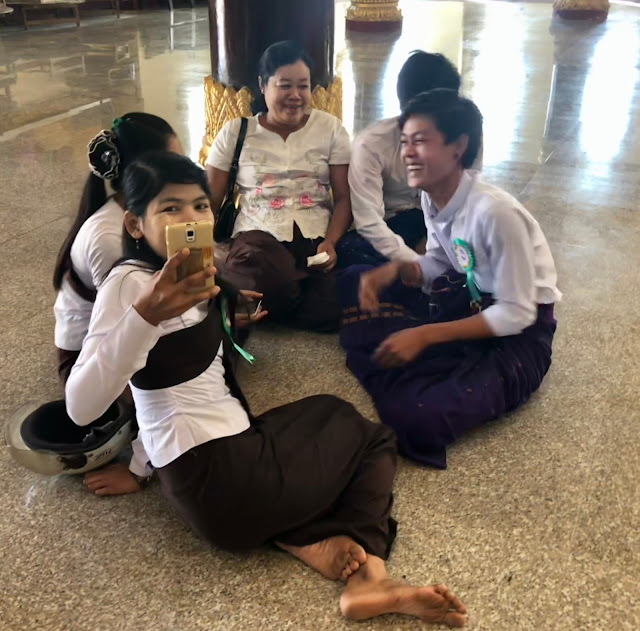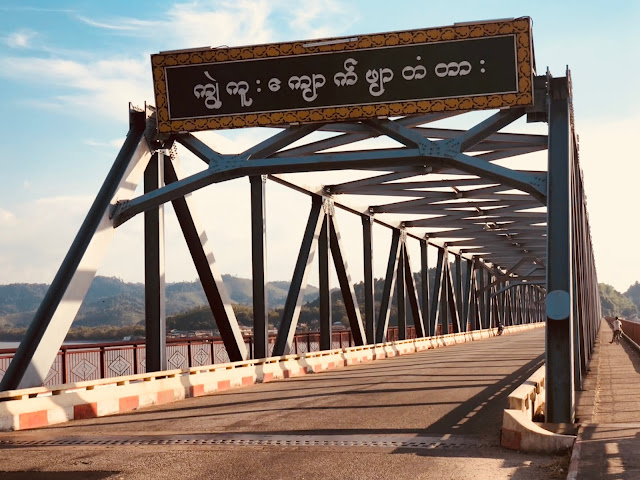Before I left, we considered several times whether to cancel the trip to Myanmar because of the
Rohingya refugee crisis and go somewhere else like Borneo. Based on TripAdvisor forums and hotels at 1/3 capacity, many other travelers had the same question.
In the end, we decided to go and were glad that we did. We did not go to Rakhine state, but the question wasn't ever our safety but patronizing a regime that is attacking large numbers of civilians.
Under the terms of the tourist visa, I agreed not to openly criticize the government, so I waited until I got back to post this. (This sounds terrible, but it's not unusual for countries to insist you follow their laws as a visitor or be expelled. US visitors agree to this too, whether we enforce it evenly or not. It's a sign of our privilege as visitors that we can speak out without fear or repercussions, while local residents often cannot. We did not want to compromise our guides or people we met.)
The situation with the Rohingya, dark-skinned Muslims who have lived in Myanmar near the Bangladesh border, has been disintegrating for at least five years, but it got much worse this fall. The UN has described it as ethnic cleansing.
Roughly
700,000 Rohingya are now refugees in Bangladesh. More than 6700 were killed by the Myanmar military (Tatmadaw) in August and September, by their own admission. Women were raped, children brutally attacked. UNICEF found 1/4 of the children in refugee camps are acutely malnourished. Although Myanmar has said they will be allowed to return in coming months, it's not clear where they could go that they could be safe.
The NY Times, when it decided to cover the story, posted powerful photographic evidence. Warning: the linked stories are graphic and heartbreaking.
The accepted narrative inside Myanmar is quite different: t
he Rohingya are referred to as Bengalis. Otherwise reasonable people, usually ethnic Burmese, insist the Bengalis do not speak the language, they don't fit in culturally or try to. They should go back where they came from.
Burmese will point to Muslims (and Christians) who live in other parts of the country, and we did see mosques and churches in Yangon, Dawei, and even Kalaw.
The issue seems less religious than tribal and perhaps, given how dark-skinned the Rohingya are, racial. Myanmar is in many ways a fragile constructed nation, at the intersection of Bangladesh, India, China, Laos, and Thailand, with a variety of ethnic groups dominated by the Burmese.
The story falls apart with the incident that was used to accelerate removal: an attack on a police station. You will hear that
Bengalis are terrorists, that they burned their own villages to the ground. (Why would they do that?) That Aung San Suu Kyi only wants peace.
The
Dalai Lama had just been to meet with her when we arrived in December; he pussy-footed around the subject and then made increasingly stronger statements. One trouble is she doesn't control the military and
so far, hasn't been able or willing to tackle this directly. Meanwhile there are other insurgencies with ethnic groups in the north and the east that potentially threaten her tenuous peace process and unified federalist democracy strategy.
Meanwhile
two brave Myanmar reporters from Reuters, Wa Lone and Kyaw Soe Oo, face long prison terms for exposing the mass graves. And they aren't the only journalists facing arrest, just the ones employed by a Western news agency.
If you've been reading my blog posts on Facebook, perhaps you, like my friend Ruth who first commented on this topic, have been confronted by the ugly juxtaposition of my accounts of friendly locals and sparkly temples with FB-suggested stories on ethnic cleansing. My Mom emailed me, worried.
A Canadian diplomat who is ambassador to Indonesia, Peter MacArthur, got into trouble after tweeting photos of Ngapali Beach in Rakhine state over the holidays; his wife is Canada's ambassador to Myanmar.
Obviously I'm not an expert. The political situation 20 years ago, when I first planned to visit Myanmar, was not exactly better than it is now; average people had much less freedom then, and most areas were off limits to visitors. We just didn't have photographic evidence of a horrific, manufactured refugee crisis on the front page of the NY Times.
That's not an excuse. I have traveled in Tibet and China, and in South American countries with repressive governments, as well as in the Middle East. On my way home, I spent the night at a Holiday Inn in Guangzhou where the room binder assured us internet speed might be slowed down for sites like Google and Facebook and Twitter, for surveillance, and for our own good.
It's always appropriate to ask whether your tourism is supporting a regime responsible for violence, just as we ask those questions of our own government. And to consider what you can do, aside from vacationing elsewhere.
Globally, especially in activist circles,
you'll hear great disappointment in Mother Suu, the Nobel Peace Prize recipient, from the world community that knows her as a political prisoner who was freed and won elections for her party. Why doesn't she do more?!
But her leadership derives at least as much symbolically from her father, the founder of modern independent Burma, which he did not live to see, as from her own limited political experience experience.
I found this sympathetic explanation in a TripAdvisor post:
We felt very safe during our time in Myanmar and only saw police/soldiers outside Mandalay palace (as their barracks take up part of the complex). As noted above, the people were really friendly but the struggles which Myanmar still faces to improve its country’s and its people’s prospects were apparent to us. Aung San Suu Kyi’s government is only quite slowly managing to make some changes as it is very, very hampered by so many things: an extremely biased constitution which guarantees one quarter of the parliamentary seats to the military and enables them and their allied parties major control in parliament; the demands of the country’s many diverse ethnic groups; and the need to address the multiple problems her government has inherited after years of corruption and mismanagement by the military government (debt, poor infrastructure, underinvestment in education, health etc., the bad deals which the corrupt military elite had committed to with overseas investors such as the planned Myitsone dam (which will have primarily negative environmental & economic impacts for Myanmar).
‘The Lady’ has made some progress in brokering peace deals with some of the separatist and armed groups in ethnic border regions (many of these groups’ discontents festered under the military dictatorship) and was on the verge of trying to develop a solution in Rakhine on the basis of Kofi Annan’s recommendations for Rakhine when, just hours after Annan submitted his recommendations for resolving the distrust and conflict in Rakhine state, a Rohingya militant group coordinated around 24 concurrent attacks on police posts killing around 30 people. Aung San Suu Kyi has almost no power over the military who have responded to this groups' attacks in Rakhine in a very heavy handed manner and once again this region is in a terrible mess of conflict and abuse (The Constitution dictates that the commander-in-chief of Myanmar's Armed Forces is his own boss and cannot be fired). Thus, in Rakhine, Aung San Suu Kyi faces another situation where she has limited power and has to work a political tightrope as she tries to address the very complex and long-standing conflicts in the Rakhine region.
I would add that while we experienced relative freedom of movement exploring the cities and main towns, major roads are controlled with checkpoints. Tourists are only allowed to stay in official lodging, and airline tickets, bus tickets, and train tickets require a lot of passport copies. It's not clear anyone is looking at all these copies; they feel like leftover British empire bureaucracy. But the same checkpoints digitized are easy to map.
In Myanmar, I heard praise for Barack Obama, who first visited in 2014 and then officially lifted sanctions against Myanmar in 2016, and some muted sadness that Donald Trump had not chosen to visit Myanmar. (That's one silver lining, in my opinion, though a very small one.)
I hope to return to Myanmar. There is so much more to see, and while ordinary people who work in tourism are definitely feeling the lack of holiday season tourists, I'm not sure the military cares.
The Hindu says this year is critical for Myanmar. I agree.
Is there an end game or a strategy by which these refugees end up safe, with children in schools, rather than in refugee camps on either side of the border?
Organizations where you can learn more or donate to the Rohingya refugees:
BRAC, UN Human Rights, Islamic Aid, Save the Children, Doctors Without Borders
A thoughtful update on Myanmar's journalists and media under threat, with background on the repressive Colonial-era laws being used to charge them





























































